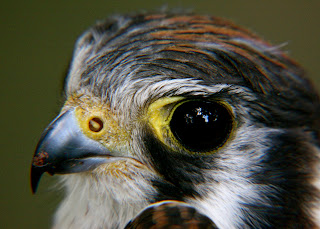 |
| Donald Stock 2012 |
This female American kestrel was spotted frequently hunting in the grassy meadows of the Grange Insurance Audubon Center before she was captured in our mistnet in August. American kestrels are sexually dimorphic, meaning the males and females look different. Males have blue-gray on their wings and a rufous-red tail with one black subterminal band, while females are duller, with brown wings and multiple bars on their tail. We aged this bird as a hatch year using the terminal band on her tail.
Kestrels are the smallest falcon in North American, and are related to the peregrine falcon and merlin, both of which have also been sighted at the Grange Insurance Audubon Center! Sometimes called sparrow hawks because of their small size, American kestrel’s scientific name, Falco sparverius, means “falcon of the sparrows”. It is very common to see kestrels on a high perch, such as utility wires, tall isolated trees or fence posts, scouting for their prey. The majority of their diet consists of insects (love those grasshoppers!) and small mammals, but urban kestrels have been shown to have a diet consisting primarily of small birds.
Kestrels often bob their heads, which allows them to estimate distance. Their large eyes sit forward on their head, which allows them to have great depth perception. Their eyes also have a high density of cone receptors, enabling the bird to see detail from great distances! One last awesome fact about their eyesight! They can see in the UV spectrum, which allows them to see the urine trails of the small mammals they are hunting as they hover over a field. COOL!
Kestrels often bob their heads, which allows them to estimate distance. Their large eyes sit forward on their head, which allows them to have great depth perception. Their eyes also have a high density of cone receptors, enabling the bird to see detail from great distances! One last awesome fact about their eyesight! They can see in the UV spectrum, which allows them to see the urine trails of the small mammals they are hunting as they hover over a field. COOL!
 |
| Donald Stock 2012 |
What you can do: If you have suitable kestrel habitat on your property, you too can aid this bird species by maintaining natural nesting options such as retained snags, or by providing artificial cavities in the form of nest boxes!
No comments:
Post a Comment